If you have to record musicians, podcasters, or high -quality audio on your computer, phone or tablet, you need a USB audio interface that allows you to connect a microphone or electrical instrument.
List of Top Best Audio Interfaces to Get in 2025
1. Behringer U-PHORIA UMC204HD
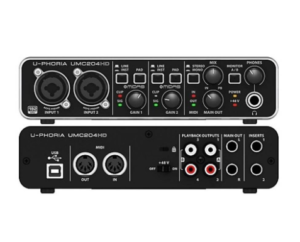
Behringer U-PHORIA UMC204HD is a two-channel USB power audio interface with surprisingly excellent performance at budget prices.
In addition, the function and connection options are usually found in more expensive interfaces.
Behringer U-PHORIA UMC204HD has a strong, all-metal structure and a strong plastic handle that is not shaken. This is a bigger improvement than all plastic structures, the Behringer UM series.
The front panel has two XLR/6.3mm combo jacks, so you can use the XLR or 1/4 “jack. There’s a control button next to the socket. One is a switch that can switch between the line and the instrument.
When connecting audio equipment, you need a lines and need some signal boosts for other or other instruments. The other control is the ‘PAD’ button, and the input signal is immediately reduced to 20dB.
There are also two indicators per channel. At the bottom, whenever the input signal is detected, ‘SIG’ is displayed in green, and if the signal is too large, the red ‘clip’ display is displayed.
This is the same as the basic level meter, but it is enough to set the gain level with the gain input knob.
On the right side of the front panel is a stereo/mono button, so you can listen to the contents of both ears. There is also a direct monitoring function.
There is a mix dial that can adjust the amount of computer playback audio with a mix dial and the amount of direct microphone signals.
When the MIDI signal is activated, there are two MIDI and OUT indicators, and the main volume control of the studio monitor is displayed.
Next to it is an A/B output button and switches between two additional stereo output sets on the back of the interface.
The power was powered by the light and led by Phantom Power. Finally, there is a 6.3mm headphone jack with its own volume control.
On the back of the Behringer U-PHORIA UMC204HD, there are 48V power switches, USB Connection, Midi, and Out Sockets.
There are also two stereo RCA playback output sets. You can use only one set at a time with monitor A and you can use the monitor B selection switch on the front panel.
This allows you to connect a small mixer, recorder, or HIFI speaker set to check the mix.
Behringer also adds two 1/4 insert points to connect to an external signal processor.
In addition to the RCA output, there are 1/4 or 6.3mm TRS jack set to be used as a major output. Their volume is controlled by the volume control of the front panel.
The U-PHORIA UMC204HD uses a standard 24-bit digital-analog converter, and Behringer claims dynamic range 110dB.
The test looked a bit lower than this, but there was no problem. The microphone preamp was quiet while using the SHURE SM58, a dynamic microphone with a weak audio signal.
An additional fetheed or CloudLifter is not required to increase the signal. If you use a quiet microphone like Shure SM7B, you will have enough headroom to stay near the microphone.
The strength of the Behringer U-PHORIA UMC204HD has a maximum input level of +20 dBu. This means that it is easy to handle a very large signal.
2. Focusrite Scarlett 2i2 4th generation

Focusrite Scarlett 2i2 4 GEN is one of the most popular audio interfaces for justifiable reasons. It is a master of all transactions with its function as a transparent preamp.
Focusrite Scarlett 2i2 4 GEN is suitable for those who want to establish home studios with compact size, low price and powerful features.
This gorgeous kit provides excellent recording quality for a recording guitar at home, using it as a mobile recording equipment, or for live shows.
The huge features of the Scarlett 4 Gen interface are very user -friendly.
Automatic gain is automatically adjusted to the intensity of the input signal, while the CLIP Safe cannot push the signal with distortion and both are excellent tools for beginners.
We like the sound of ‘Air’ preamplifier emulation that adds high -ends to the signal, and you can rewrite it to add some saturation.
The Focusrites driver offers very reliable performance in both Windows and Mac, but in the latter, you can take a step further using ‘Codeless Kernel Extension’.
This allows you to honestly drop the waiting time to less than 5ms mark, which is an amazing number.
It is worth it if you want to use a faithful installation, but if you want to use a synthesizer plugin in a live scenario.
The latest repetition of the Focusrite audio interface provides fantastic performance for recording musicians, whether you connect the guitar to the front or the vocal microphone on the back.
The huge profit of the preamp means that you can handle a variety of applications, from the quietest vocals to the largest snare drums.
3. RME BABYFACE PRO FS

BABYFACE PRO FS is a high-quality 2 input 2 output USB bus power audio interface.
Babyface Pro FS, famous for its high level of flexibility and customization, has amazing microphone preamplifiers and digital-analog converters.
The first thing that stands out is how solid the Pro FS is. It’s like dealing with smooth metal bricks. Minimum design, six allocated buttons and the dominant wheel in the center.
On Rotary Dial, there is a set of 4 level meters that can display the input level (left) and output (right).
Using a dial to set many other features under the hood of input gain and this powerful interface.
The rear panel has two XLR microphones, with an impressive 76dB gain. This XLR can also be converted to allow a balanced line level input.
If you use XLR on the back or 1/4 on the side of the line level input, you can expect an almost perfect flat frequency response.
On the right side of the Babyface Pro is 2 lines of Hi-Z device input and is automatically detected in the signal. Using this input, it is used to record an electric guitar or base or connect audio equipment.
You can select 2 headphone sockets, an Impedance 3.5mm jack, and a 10 OHMS impedance 1’4 jack.
This has a lot of flexibility in matching the headphones that need to be taken while maintaining optimal audio accuracy.
At the same time, you can use two headphones, but there is no volume control.
There is a MIDI socket on the left side of the Babyface Pro. Use the provided lead to break down two old school 5 -pin plugs.
This allows you to connect a keyboard, drum machine, or MIDI controller. There is also digital out-and out for various expansion options. Select SPDIF and ADAT to add 8 channels.
There is also an extra Beef USB-B socket to avoid 12V DC power sockets and loose connections for using BabyFace in standalone mode.
RME is well known as a stable driver and a reliable watch. It is especially important when connecting other digital equipment, but it is a good sign that the equipment is unlikely to fail when playing live.
Using the highest quality preamp and digital analog converter, the sound is as clean and clear as I heard. Transparent and honest.
We tested the FS Pro with multiple microphones and various recording situations. It has no hiccups, no hiccups, and perfectly performed nuances and clarity.
The last thing to mention is TOTALMIX software. It is a very powerful mixer that can do the most complex routing if necessary.
This includes three EQ bands for effects, talkbacks, and outputs.
If you don’t have time to explore the depth of TOTALMIX software, you can simply set it to the ‘Digital Work Station Mode’ that can integrate it smoothly into the DAW.
4. MOTU UltraLite mk5
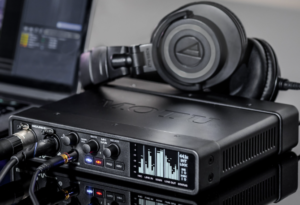
MOTU ULTRALITE MK5 is an eight-input USB audio interface, with a 2 XLR jack for the microphone and a 6 1/4 jack line input.
With a total of 10 line -level outputs, additional digital inputs and outputs, this product is a variety of interfaces with very good audio quality.
MOTU ULTRALITE MK5 is composed of four metal sections, making it strong enough to use not only studio but also live. Controls feel solid because there is almost no play on the handle.
The front panel has two combo XLR TRS combo inputs for connecting devices such as microphones and guitars. MK5 can receive a line level, device, or microphone audio signal.
Each combo input has a separate phantom power and pad switch, reducing audio signals by 20dB.
They also have their own gain knobs that control the benefits in 1dB from 0 to an impressive 74dB.
Dedicated 1/4 -inch headphone jack is easy to access and can be easily accessible where the volume control dial is located.
The output impedance is low, so you can get good results and high signals with a variety of headphones. Small niggle -Be careful not to rotate the dial too quickly -you can start a missing step.
Pressing this volume rotary encoder changes the tolering function between the main volume output and the headphone volume. And if you press and hold for a few seconds, the interface will turn on or off.
On the right side of the front panel is a black-and-white OLED display, which is useful for seeing the level of all inputs and outputs.
The level meter is clear and easy to see, but it is difficult to see when the signal is close to clipping without the green, orange, and red warning colors.
It would be a good idea to see the vivid green and red of the MOTU M2.
The rear panel has a DC power connector. Ultralite MK5, like most other audio interfaces of this size, does not draw power in a USB-C connection.
BOX contains a power supply and is needed to supply power to all the features provided by this interface.
Next to this, there are two existing 5-pin midi connectors (inside and outside), two SPDIF connections (inside and outside), and two optical RCA connections (inside and outside), and optical connections can be used in TOSLINK mode for two additional channels.
there is. Or as an ADAT connector for eight digital channels.
There are 10 balanced Line Out TRS 1/4 sockets along the rear panel. You can use 2 stereo outputs for the main output of the studio monitor and use it for two studio monitors, additional headphones or stage monitors.
Even though there were so many functions small interface, there was no compromise on sound quality.
They are characterized by the famous ES9026PRO digital audio converter, and MOTU claims that it offers 125dB of dynamic range.
In the test, it does not reach that value, but it still achieves a huge dynamic range.
The preamp is quiet and the distortion is lower than the noise floor.
With a gain of about 75dB, cloud lifters or fethead are not needed to increase the signal. MOTU ULTRALITE MK5 provides excellent sound quality in the input and output stages.
CUEMIX 5 You need to access most MK5 controls using the software.
It works on Windows, Mac, and iOS devices. There are many features, including amazing routing flexibility.
You can create an individual mix and set the loop bag for the specified line output.
There is an effect of the available EQ, compression, gate and reverb. It is almost real-time effect because the waiting time is too low.
Ultralite’s general round -trip waiting time is very good, but of course, it depends on the sample speed and buffer size.
5. Audient ID4 MKII
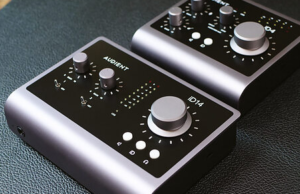
Perhaps the best audio interface for less than $200, ID4 MKII is a simple 2 input/2 output product featuring a MIC preamplifier, with phantom power to use the condenser microphone.
A simple control system is good for beginners, but it has a deeper feature if you run out of the stage.
Everything is driven by USB-C, and Apple’s camera connection kit can also work on iPhones/iPad.
But for us, the studio Devilry is in the details.
Audient has actually thought about everything with the value and usefulness in mind, and it makes us feel what the budget solution is, but it is cheaper.
We like JFET instruments to connect electric guitars or bass, which provides characteristics similar to the input of the tube amplifier.
It offers great basic tones for using other VSTs and is good for other players who want to record for the first time.
The microphone preamp is characterized by a healthy 58dB gain for a quiet dynamic microphone when recording vocals or other traditional instruments.
Using Smart Scroll Wheel allows you to adjust your settings in a nice touch software, and we’re a passionate fan of the dual studio headphone output, so it’s good for recording band members or working with other musicians.
The design is very well thought out, which is another mite of a box that makes ID4 familiar to beginners.
6. Behringer U-PHORIA UMC22

Behringer UMC22 is incredibly cheap. Nevertheless, most musicians can still perform fantastic tasks in most work that require an audio interface.
It is difficult to find something wrong given the price of Behringer U-PHORIA UMC22.
Of course, there are people with more connectivity and functions in a better quality preamp age list, but with the best budget audio interface, it is much better or much cheaper.
MIDAS PREAMP provides excellent quality for recording vocals and others, and does not provide standards of others on the side of the noise floor, but can be fully used for anyone other than professional engineers.
We will do fantastic things to demonstrate the song at home or to receive simple recordings for various purposes, so we will do everything we need without excess lint.
Out Let Down does not have a dedicated Windows driver. Therefore, the Google search should be taken through a third-party driver (asio4all is optional).
If you do this in this way, you can get sound from one source depending on the setting, and it can be limited to some users.
These are small problems, and it’s hard to knock on getting money here because it costs less than the average overlive pedal.
Although there are no shiny species and whistle that others can boast, the function set includes a bass that includes phantom power, headphone output, and a dedicated gain knob for each input.
7. Focusrite Vocaster 2
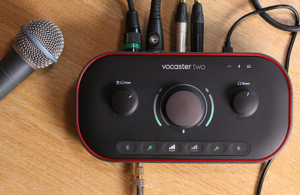
The maximum digital recording resolution is only 24 bits/48 kHz, which is enough for podcasting, but is lower than most music producers prefer.
Even the included software packages include a six -month test subscription for the Hindenburg Lite Audio Edit Program and ACAST, AMPLIFY Studio, and Squadcast Pro.
The output of the headphone amplifier is 1.2dB less than the headphone amplifier of the Focusrite Scarlett 2i2 4 Gen.
If you record a podcast without a guest or all guests can call or sign up via Zoom, RiverSide FM, etc., you can choose a low -cost Focusrite Vocaster.
There is a single input and lacks Bluetooth function, but basically the same device.
Compatibility with iOS devices is limited. This model works only on iPads with USB-C jacks, not other iPad or iPhone.
It also lacks sound effect trigger pads, as you can see on a podcasting platform with complete features such as RøDE Rødecaster Pro II.
The control layout of this interface is designed for podcasting, not music recording, and includes the ability to add professional luster.
This interface is not our choice for recording music, but people who are serious about podcasting are probably worth the investment.
The best feature is the Enhance Tool, and independently select one of four sound dictionaries for hosts and guests. The dictionary settings are clean, warm, bright, and displayed on the radio.
All add dynamic range to soften the peak and dip of the sound and soften the low pass filter to reduce collision sound, footprints, and microphone noise.
The operation of the mode is very consistent with what the name suggests.
Our favorite radio cut a little bit of mid-range and strengthened the bass. Dennis, my podcast partner, and I have always found it using it because our voices are a bit richer and clearer.
Gain-level settings for hosts or guests are simple. Press the button of the input and speak to the microphone with a normal voice for 10 seconds.
Then the system automatically makes adjustments. You can manually adjust the gain with a central handle using a large and intuitive level meter that makes the left and right handles in parentheses.
Vocaster Hub Computer App offers a screen mixer that controls the functions of many Vocaster Two and integrates audio from Loopback Audio and Bluetooth and Line input.
8. Universal Audio Apollo Twin X
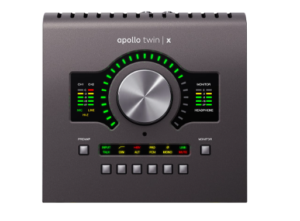
Universal Audio Apollo Twin X is one of the best-quality audio interfaces available at home recording levels.
DSP power ensures minimal standby time, and Thunderbolt drive integration in the Mac ecosystem provides unrealistic performance.
There are two hybrid XLR/jack inputs with the instrument input on the rear, ignoring one of the back connections on the front.
This is not much different from other desktop -based interfaces, but the clever bit is how unison preamps match the DSP processing.
That is, it can be loaded on the vintage NEVE channel strip, which can modify the operation of the analog input for some cluttered recreation of the ‘appropriate’ recording studio channel.
On the front of Apollo Twin X, there are huge handles that can be used for volume control of studio monitors, headphones and input gains, phantom power, muting and other functions.
We knew that it was an incredible and powerful recording experience using one of these, and it is a perfect interface that combines the portable size to travel and go to the recording session. In the UA ecosystem.
Legendary La-2a and 1176 Compressor plug-in, PULTEQ EQ plug-in and bass legendary LA-2A and 1176 compressor plug-in and AMP mode sellers are provided in the interface.
If you haven’t built a plug -in collection yet, it’s a very perfect product that can be completely integrated with the UA’s LUNA DAW.
FAQs
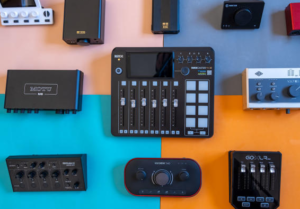
What is the audio interface?
Think of the audio interface as the middle between music and computers. The interface is taken to take the music input and convert it to 1 and 0 that computers can understand.
This process occurs through the digital (ADC) converter in the analog of the interface.
After these signals are on the computer and are manipulated (usually DAW), the audio interface guys 1 and 0 can be converted to a waveform to play through the studio monitor or headphones.
This process is done through DAC (Digital to Audio Converter).
Who is the audio interface?
The best audio interface is for those who want to record audio. Electric guitars, EDM tracks, and podcasts are to get audio in the latest streaming episodes.
There are many cases of use for those who need an audio interface and are reflected in the product selection of this guide.
Does the audio interface improve sound quality?
If we think that the new audio interface will improve the recording quality, we will be straight with you. This is not true.
At the consumer level, most audio interfaces provide very similar recording quality. The difference is that the signal enters the interface.
Therefore, the studio uses an outboard gear such as a preamplifier, EQ and compressor, using the signal before entering the DAW.
In short -it is much more important than the actual interface if it is in the DAW before going to the interface.
If you look at the interface vs. built -in sound card on your computer, improve the sound quality. The audio interface converts analog sound into digital and vice versa.
What are the various types of audio interfaces?
Most interfaces do quite similar tasks. The only main differentiated element to consider is the connection.
Some use USB, Thunderbolt, Firewire, or PCIe to connect to laptops or computers. Most interfaces offer USB connections, but they are always worth double-checking to see if the computer has the right port.
In this article, let’s look at the difference between the Thunderbolt and the USB audio interface.
What is the allowable waiting time for the audio interface?
Most musicians will not say at all! However, it is impossible when convert audio into digital, so you need to endure some standby time when recording.
We are excellent for all less than 20ms, and most musicians do not know this waiting time no matter what instruments are played.
One exception is vocal, where even a small amount of waiting time can actually be put.
This is because the vocalist will listen to the sound of the head before a slightly delayed vocals through the headphones.
Good recording vocals can deal with this, but you may need to disable the plug-in to fully lower the waiting time for less experience.
What is a popular audio interface brand?
There are many audio interfaces available today, but popular brands include Audient, Arturia, Behringer, Focusrite, IK Multimedia, Motu, Native Instruments, Presonus, Rode, SSL, and Universal Audio.
Also read: Best Audio Interface for Vocals in 2025
